As unpredictable as the weather is in the UK, November is celebrated as being the best time of year to plant trees. Factors such as stable temperatures and high rainfall levels help roots to grow and settle before winter arrives. Trees planted in November also require less aftercare than trees planted in other seasons, because of this, an annual event was launched to coincide with this.
National Tree Week is the UK’s biggest annual festival of trees and it aims on encouraging a positive attitude about planting trees. This year, National Tree Week is running from Saturday 26th November to Sunday 4th December 2016 and will inspire a quarter of a million people to use their green fingers to plant around 1 million trees around the country.
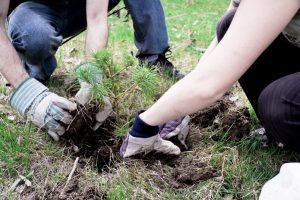
The Tree Council is the UK’s lead charity for promoting the importance of trees and is responsible for organising National Tree Week. National Tree Week was first introduced in 1975 highlighting the fact that the UK is one of the least tree inhabited countries in Europe. Around a million trees are planted each year by schools, community organisations and local authorities to aim at combating this problem.
For those who are unable to plant a tree, there are many other ways to get involved. You can contribute by adding a tree story or memory for the Charter for Trees, Woods and People which launches in 2017. Alternatively, if you are feeling creative, you can take part in the annual Tree Dressing Day taking place on Saturday 3rd December. Tree Dressing Day is based on ancient traditions and customs from all over the world and is a great way to raise awareness of the importance of trees in the public domain and hence value and care for trees a lot more.
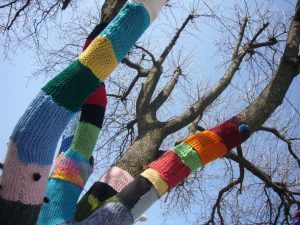
London Tree Week
Strangely enough, despite tradition, London hosts its tree week in May and not in November like the rest of the country. The Mayor of London runs the event in May of each year where you can get involved with various activities and events. These events include learning about the history of London’s Mulberry trees, going for a walk around the urban forest at the Heygate Estate and attending evening talks from industry professionals.
If you are passionate about photography, there is also a London Tree Week photography competition where you can share your photos of social media platforms and organisers choose a photo of the day and a photo of the week.
If you would like to keep up to date with information about next year’s London Tree Week, follow @LDN-environment on Twitter or visit:
https://www.london.gov.uk/search?s=tree%20week.
Alternatively, to find out more about National Tree Week events happening near you, visit:
http://www.treecouncil.org.uk/Take-Part/Near-You
Experts have warned that the playground classic, the conker, could be wiped out in just 15 years. The population of the horse chestnut tree is under threat due to an invasion of an exotic pest combined with the spread of a killer disease.
Leaf Miner
The horse chestnut leaf miner originally observed in Greece has spread throughout central and Eastern Europe during the late 1980’s and was first observed in the UK in 2002 in Wimbledon, London. Since then, leaf miner in horse chestnut trees has spread throughout the majority of England and Wales and was first observed in Scotland in 2015.
Horse chestnut leaf miner is caused by a small moth whose larvae feed inside the leaves resulting in brown or white blotch mines to develop between the leaf veins which destroys most of the leaf tissue. This can impact on the typical autumnal falling of the leaves, with horse chestnut leaves defoliating before this seasonal event. Research has suggested that by as early as August, a substantial proportion of the leaf surface will be inhabited by leaf miner, giving the impression that the tree is dying.
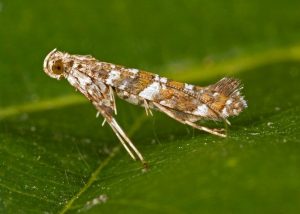
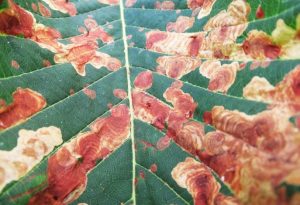
Investigation into leaf miner how shown that generally, when new horse chestnut trees are planted, they don’t survive past 5 years old as leaf miner defoliate the leaves so that they can no longer produce enough for new trees to grow.
Although the leaf miner moth causes significant damage to the leaves on an annual basis, on it’s own, the pest doesn’t normally cause damage to older horse chestnut trees’ health as they usually bloom again the following spring.
Mature trees are strong enough to withstand the effects of leaf miner, but are deteriorating from a disease called the bleeding canker and even impact on the reduction in the size of conkers. It is believed that leaf miner combined with bleeding canker will leave horse chestnut trees susceptible to die-back.
Bleeding Canker
Bleeding canker is a disease that particularly infects the bark of horse chestnut trees caused by the pathogen Pseudomonas syringae pv. Aesculi. As a result, dark red/brown sticky liquid bleeds from cracks in the bark. The effect on the tree is variable in most cases, with some infections lasting for years with little damage. Others spread rapidly causing the crown of the tree the thin and die-back. The incidences of the disease in the UK has risen dramatically in recent years which is thought to be due to warmer winters and wetter summers.
Bleeding Canker combined with leaf miner is having a devastating effect on the population of horse chestnut trees nationally. Once in a location, most of the trees in that area will suffer and die within a couple of years. Council health and safety officers are implementing the removal of horse chestnut trees for fear that damaged branches will fall and injure passers-by.
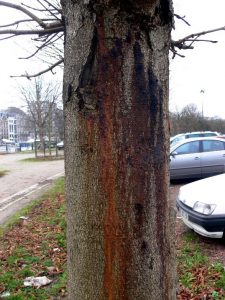
Control
Confirming the cause of symptoms for both leaf miner and bleeding canker is essential to provide recommendations for effective control measures. The Forestry Commission suggest the following guidelines:
Leaf Miner
Damage can be reduced by removing fallen leaves and composting them thoroughly.
Cover piles of damaged leaves with soil or other plant material to prevent adult emergence of moths the following spring.
Purchase a horse chestnut miner trap which uses pheromones to attract and catch adult moths to reduce the mating of the moth to help in the decline of the infestation.
Bleeding Canker
Some infections do stabilise, so it is important to note that immediate removal is not required in all circumstances, but keep close observations on affected trees.
If the condition continues to decline, remove any major branches that are infected. Dead branches may suddenly break off as the wood dries out.
Where lesions are extensive the entire trunk may have to be girdled, however, this will cause the tree to die and will need to be subsequently removed.
Disinfect tools after use to prevent contaminating other trees.
Plane Tree Wilt (also known as canker stain disease) is currently rapidly spreading throughout North France and is closing in on Paris. The disease affects ‘plane trees’ which are prominent features of parks and avenues across the world. The disease has already ruined miles of historic tree lined areas in France, such as Canal du Midi.
Jago Keen, Chairman of the Arboricultural Association has been reported as saying “If the disease gets to London the impact would be catastrophic”. More than half of London’s trees are plane trees and one of London’s most famous streets, The Mall, is lined by them. Some of the trees lining The Mall are over seventy years old, and replacing them from new to the size they are would take decades.
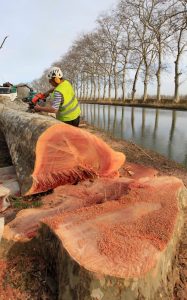
Canal du Midi – France
How Does The Disease Spread?
The disease, which is caused by the fungus Ceratocystis platani is currently present in the USA and Europe, and is thought to have originated from North America. It was then transferred to Europe in WW2 when wooden box used by the USA for packaging supplies were infected.
The fungus that causes this disease infects the tree through wounds in the bark, branches or stem. Sawdust containing the fungus, contaminated machinery and soil can also start new infections in other trees. Additionally, if the trees roots come into contact with another trees roots the fungus can use that to spread to the other tree.
To explain the impact this disease would have on London, Jago Keen warned “It would kill a large number of plane trees very quickly. The Mall would disappear practically overnight, as well as Broadway and Berkley Square. They would take a long, long time to replace. You would have to cut the dead trees down, then replant and wait for them to grow. We would have to wait 60+ years to restore the current look.”
What Are The Symptoms?
Wood / Bark
For trees with thin bark, there may be sunken lesions, possibly with orange and purple streaks. In trees with thicker bark, one of the more common symptoms is the appearance of vertical cracks in the bark. When the bark is pared away, leopard like spots (brown to dark violet) appear in the outer wood.
Foliage
One of the first visible symptoms is a sudden wilting of foliage on one branch on the tree. Some trees can also have yellowed leaves further up the tree.
How to Control the Disease
The fungi can survive for months or years in affected wood. The best way to control the spread is to remove and burn any effected wood. Currently no chemicals tested have been affective against the fungi. Another effective precaution is to disinfect tools as spores can remain for up to a month on tools.
How Can I Help?
The Forestry Commission has a handy ‘Tree Alert’ page, where you can report sightings of plane tree wilt and other diseases – visit www.forestry.gov.uk/treealert. They also request that you supply photos of the symptoms, full detail locations, contact details and if possible information about the age of the tree (e.g. mature or recent planting).

Tree felling dates back thousands of years – it was used in ancient times as an effective space maker, and still is now. It was almost essential for the survival of mankind, as it provided wood for fires and shelter.
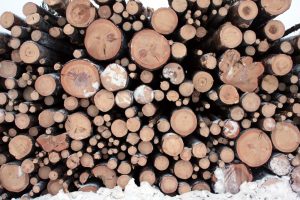
Evolution of Tools
Tree felling dates back hundreds of years, and was first used to clear areas for farm land, collect firewood and build houses.
In ancient times, trees were burned to the ground, which meant it was likely trees could fall in any direction, making it dangerous. Nowadays, we careful plan the direction trees will fall so that objects of modern life, such as houses, gardens and outbuildings don’t get damaged in the process. We take on both residential and commercial jobs, and our qualified tree fellers will make sure that your property is protected before the job is done. After this, the axe evolved into a stone tool, like tomahawks.
In the 18th century, the axe evolved a wedge shaped blade. This was much more effective in chopping down trees, and had power that made the job easier. Tree felling was also important for creating fuel, as wood was a primary source of energy for a long time. At Complete Tree Care, we have modern and tested chainsaws, which help us get the job done quickly and efficiently. All of our staff are fully trained to use our equipment to ensure optimum safety.
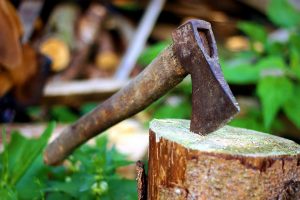

Complete Tree Care
We have over 15 years’ experience of in the tree care sector, so you can rely on us to get the job done safely and properly. We hold £10 million of cover, and we’re also local authority approved, so you can rest assured that we follow all health and safety procedures to make sure our jobs is done correctly.
We don’t just perform tree felling – our expert team are ready to tackle all of your tree surgery needs. Our tree care specialists are available for work across London, including Twickenham, Hounslow, Ealing and Richmond.
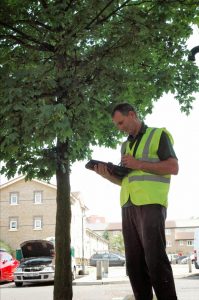
At Complete Tree Care we have been providing a reliable and knowledgeable service for 15 years throughout London. No job is too large or small, we’re local authority approved and we can help you today. Call 020 8616 9051 or fill out our contact form on the right for advice and bookings now.
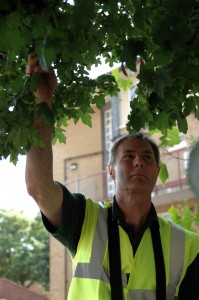 What?
What?Giant Hogweed, whose botanical name is Heracleum Mantegazzianum, is an invasive plant that spreads rapidly from woods and wild areas. With small white flowers that make little domed or flat umbrella shapes called umbels, the giant hogweed’s stems are green and bristly, sometimes with purple blotches. A close relative of cow parsley – condemned as the countryside killer by the Independent – giant hogweed is an imposing sight when fully grown. The plant originates from North-Western Asia and is a UK non-native – when left alone, they can survive for up to 15 years.
Giant hogweed is classed as an ‘invasive alien’, and as such it is an offence to cause giant hogweed to grow in the wild, and some landowners have even been presented with an Anti-Social Behaviour Order and ordered to remove the weed or face penalties. Often local authorities will take action and remove this stubborn plant from public areas.
The sap from a giant hogweed plant can cause skin burns on contact, so many gardeners decide to have it removed to avoid accidents. Giant hogweed contains high levels of furanocoumarins, a chemical that can cause burning when skin is exposed to sunlight, as well as other skin complaints. This also makes it particularly dangerous to animals who’re unaware of the harm the plant can cause them and as such don’t avoid it. Children are known to be particularly sensitive to the sap, and can as such suffer with bad reactions.
Just like humans, the sap causes burns and other skin problems when it comes into contact with skin (or fur) of an animal, but it is also poisonous when ingested. Animals are particularly sensitive to eye damage, and if the sap from a giant hogweed plant comes in to contact with your dogs’ eyes it can lead to permanent scarring of the eyes or cloudiness of the corneas. This can inevitably lead to loss of eye sight.
Giant hogweed removal can be done in two way: non-chemical, and chemical. Non-chemical means removing the plant from all affected areas, or sometimes suppressing with mulch. Attempting to control or remove giant hogweed when ill equipped or ill prepared will inevitably cause harm. All skin should be covered, and masks should be worn when working on or near it. The debris of cut plants and clothes that have been contaminated are just as dangerous as the plant 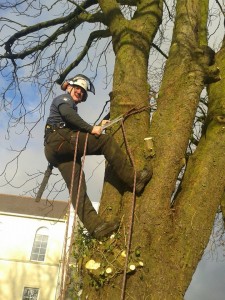 whilst in the ground.
whilst in the ground.
As giant hogweed is attracted to moist soil near waterways, you should never allow a chemical weed killer to enter a waterway if removing the plant from close to the water. If it looks like this will happen, hire a knowledgeable professional, who will likely contact the Environment Agency.
Although some gardeners choose to tackle it themselves, we wouldn’t recommend this and instead suggest you get in a professional such as Complete Tree Care. This is because the sap can cause photosensitivity on the skin, which can lead to painful blisters when exposed to sunlight. To prevent injury and ensure the plant is handled in the best way, a expert should be used.
At Complete Tree Care we have been providing a reliable and knowledgeable service for 15 years throughout London. No job is too large or small, we’re local authority approved and we can help you today. Call 020 8616 9051 or fill out our contact form on the right for advice and bookings now.
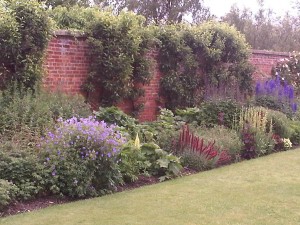 What?
What?Himalayan balsam, also known as Impatiens glandulifera, is a purple flowering, non-native plant that infests riverbanks, waste land and gardens. It can grow to 2-3m and flowers between June and October.
The attractive weeds are also known as Policeman’s Helmets due to their hooded shape, and were introduced in the 1800s along with giant hogweed, firstly as an exotic plant. It quickly grew out of hand, and in recent years has spread all over England, and suffocated our natural wildlife.
Although pretty, it smothers other plants and can kill off native plants that we want to keep as it grows quickly and attracts pollenating insects that would otherwise be drawn to more desirable plants. Each weed produces hundreds of seeds and these can be shot up to 7 metres away by their seedpods, meaning it spreads quickly and over some distance.
In the wild or in rural areas, allowing this weed to grow near watercourses can cause permanent damage by erosion to the banks. Just like giant hogweed, it’s an offence to plant or cause its growth in the wild, and some councils and organisations take action to remove it from public areas due to the destruction it causes banks of water sources, and the way it limits native plants that we want to promote the growth of in the UK.
The adult plants need to be removed before they can seed, and totally eliminating the Himalayan balsam can be a long process. Contaminated soil should not be used for other plants, as any remainder of the Himalayan balsam will result in regrowth that will potential kill the plant you’re choosing to grow. For homeowners, it produces a high amount of pollen, so is a pain for hay fever sufferers.
 How and Who?
How and Who?It is kinder to the environment to avoid using chemicals when trying to remove weeds such as Himalayan balsam, as well as necessary to avoid infecting water sources if the weed is growing on river banks etc.
Himalayan balsam removal is not necessarily difficult – pulling the weed out is the best option if it’s only covering a relatively small area. But the difficulty comes in ensuring it won’t return, as seeds can wait two years before growing. If the plant is not fully removed, it may grow back within the same season, and if you try to cut it down once the seed heads have formed, it will efficiently spread the plant further.
Although some gardeners choose to tackle it themselves, we wouldn’t recommend this and instead suggest you use a professional, such as Complete Tree Care. At Complete Tree Care we have been providing a reliable and knowledgeable service for 15 years throughout London. No job is too large or small, we’re local authority approved and we can help you today. Call 020 8616 9051 or fill out our contact form on the right for advice and bookings.
Tree pruning reduces the size of a tree. It is done for many different reasons, for example: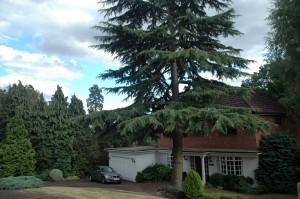
There are many methods of tree pruning that are used in different scenarios and we will pick the method most suited for your business or home. An all over trim in spring or summer can be used for smaller formal trees, especially evergreen trees such as Scots Pine. This method will need to be repeated every year or two if you want to maintain a neat look.
Pruning when dormant is a method where the side branches of a tree are removed to make the tree smaller and more pleasing to the eye. This method gives us a good opportunity to remove any damaged or diseased wood from your tree and also reduces the chance of your tree being damaged by the wind. Crown lifting removes the lower branches of the tree to allow the crown to be lifted, giving you more space under the tree to relax and enjoy the shade.
Crown thinning is a method where up to 30% of the tree crown is removed to allow more light through, as this method can ruin the appearance of the tree if done improperly we perform this service in stages to allow us to evaluate the visual changes between each stage.
Perhaps the most extreme method of pruning is pollarding where the entire crown of the tree is removed to create a smaller tree, this method is best started when the tree is still quite small and must be repeated every year to keep the tree small.
When performing any tree pruning it is important to check if the tree is protected by a tree preservation order or TPO. At Complete Tree Care, we will make sure this is taken care of for you by speaking to the council’s local tree officer.
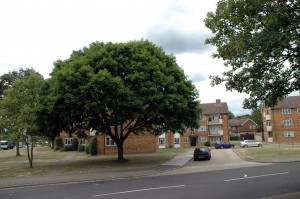 Why choose Complete Tree Care?
Why choose Complete Tree Care?Here at Complete Tree Care we believe that it is important to call in a professional when pruning trees. When done incorrectly, it can cause much more harm than good. For example, the tree disease Coral Spot may form on branches that have been badly cut and this will likely ruin the look of the tree.
We have provided tree services to several high profile clients including recently the Duke of Bedford Estates who own famous garden squares in Bloomsbury including: Russel, Gordon, Bloomsbury, Tavistock and Bedford gardens.
Complete Tree Care has over 15 years of experience providing expert tree services throughout all of London including Richmond, Ealing and Hounslow. We are on call 24/7 for emergency call outs and with over 10 members of staff we can provide fast and responsive tree surgeon services for your home or business. Either call us on 020 8616 9051 or use the contact form on the right to get free advice and an estimate.
 Tree stumps are the part of the tree left after it has been felled and depending on the size of the tree that was cut they can take up a large amount of room on your land. Tree stumps can also regenerate if the conditions are right. When this happens, small tree sprouts grow from the stump and use the existing root structure for nutrition. If the felled tree was large there may have been a huge amount of nutrients left in the roots and this can cause the shoots to grow very fast this quickly, leading to a very unsightly addition to your garden.
Tree stumps are the part of the tree left after it has been felled and depending on the size of the tree that was cut they can take up a large amount of room on your land. Tree stumps can also regenerate if the conditions are right. When this happens, small tree sprouts grow from the stump and use the existing root structure for nutrition. If the felled tree was large there may have been a huge amount of nutrients left in the roots and this can cause the shoots to grow very fast this quickly, leading to a very unsightly addition to your garden.
There are several hazards related to leaving tree stumps in your garden after cutting trees down. For example, the UK’s most destructive fungal garden disease Honey fungus (Armillaria) thrives in the rotting wood of dead trees and can cause the deaths of many of the nearby trees and other plants. If Honey Fungus has begun to spread in a garden the only remedy is to excavate all of the infected plants and then either burn them of have them put in a landfill. Another related hazard is that the stumps may become overgrown and act as camouflaged tripping hazards. If you are own a public garden this could lead to customers getting hurt which is bad for business. Perhaps the simplest problem with having tree stumps in your garden are that they take up room and are an eyesore that detracts from the beauty of your garden.
 How?
How?Luckily, there are many methods of tree stump removal that we at Compete Tree Care provide that can be easily tailored to your needs. Smaller stumps can be pulled out using a winch. This is a quick method which means there is minimal disruption to your home or business. After the stump has been pulled out the only thing that remains to be done is to fill the hole and lay turf leaving your garden looking clear and pleasing. Larger stumps can either be dug out by hand or for very large stumps using a mechanical excavator. Another method that we sometimes use is stump grinding. This uses a tool called a stump grinder to remove the portion of the stump that is above ground and therefore does not damage the area around the stump and eliminates the
need to fill in a large hole.
After we have ground down the stump to a sufficient level we can then lay down turf which leaves your ground looking good as new. The final method that we use is chemical removal where we use chemical that breaks helps the dead wood break down faster and decompose on its own. This does minimal damage to the area around the stump, however, it can take a while for the stump to decay completely.
Complete tree care has over 15 years of experience providing expert tree services throughout all of London including Richmond, Ealing and Hounslow. We are on call 24/7 for emergency call outs and with over 10 members of staff we can provide fast and responsive tree surgeon services for your home or business. Either call us on 020 8616 9051 or use the contact form on the right to get free advice and an estimate.
 Here at Complete Tree Care the winter is the time when we undertake the vast majority of our planting –at least 150 large trees and many more shrubs. Planting at this time of year, when the trees are dormant, gives the highest success rates and ensures they get off to a good start the following spring.
Here at Complete Tree Care the winter is the time when we undertake the vast majority of our planting –at least 150 large trees and many more shrubs. Planting at this time of year, when the trees are dormant, gives the highest success rates and ensures they get off to a good start the following spring.
If you are thinking of undertaking some tree planting please contact us and our manager or director (qualified to degree level in horticulture) will visit your property to give detailed advice and a fully costed quote at no cost.
We are able to undertake any size of job and by combining orders we are able to buy from our favoured supplier, James Coles Nurseries at commercial rates – representing a very significant saving over cash and carry nurseries or garden centres. We can also offer much larger trees than you would usually obtain from a garden centre, which will provide instant impact to your garden. Typically we purchase ‘standard’ sized trees which come in a 45 or 60 litre container (plant pot!) and are 2.5-3.5 metres in height!
As part of the planting process we securely stake the trees and apply a protective mulch of composted wood chips to the planting area to retain moisture and suppress weed growth the following spring.
We recently analysed our sales data to establish where we were getting most of our leads; so we could better focus our advertising. I am pleased to say that the statistics showed that most of our clients came to us by way of referral and repeat business – not through advertising!
So in the end the best way to pick up new business is to do a good job. One example was Cairn Avenue, in Ealing where we were asked to undertake tree works for three residents in the space of just one month! Similarly at Strawberry Hill in Twickenham we have been pruned trees for two neighbours this summer.